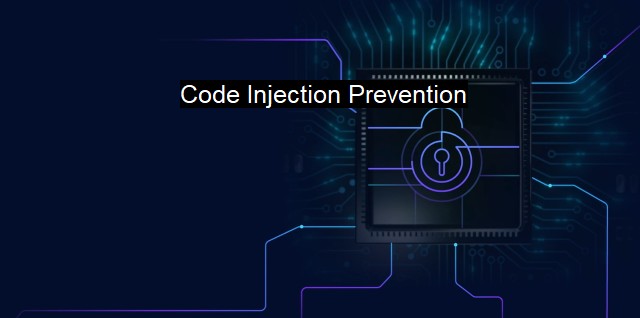What is Code Injection Prevention?
Protecting Against Code Injection: Techniques and Strategies for Prevention
Code Injection Prevention is a critical aspect of cybersecurity, involving the implementation of robust measures to mitigate the threats posed by code injection attacks. This concept revolves around the deployment of strategies and tools to thwart the potential manipulation of a computer program by an attacker through the input of harmful code, malicious scripts or unauthorized statements.Code injection attacks give an unauthorized user undue manipulation power over an application and its data. A classic scenario involves injecting harmful data into an application’s code – such as SQL, HTML, XML, or OS commands – to exploit potential vulnerabilities. An attacker might engage in this malevolent activity to hijack user sessions, steal sensitive information, change the application's behavior or gain privileged system access.
To understand this predicament, it's crucial to explore how these breaches occur. Typically, some applications use user inputs to create dynamic code, meaning a cybercriminal can inject stealthy code segments by submitting unexpected user inputs. Vulnerabilities can frequently be found in unsanitized interfaces that allow users to input data, which is then used to perform command operations without validation.
To prevent such attacks, developers implement Code Injection Prevention techniques, tools, and policies. This can range from validation methods, encoding user inputs, to leveraging parameterized queries and command-line invocations. Prioritizing secure coding practices becomes imperative, as it fosters building applications that can resist injection attacks using various input data types.
Code injection vulnerabilities can be significantly reduced or entirely eliminated through Input Validation. This involves scrutinizing every user input and carefully filtering special or non-approved character types. Here, the goal is to inhibit any carefully constructed data sent into an application to trigger malicious activity. Techniques include ensuring that all characters obtained from a user are of the correct form before any subsequent processing and preprocessing input fields to disable malformation or tampering.
Proper management of application permissions is crucial as well. This minimizes potential impacts of code injection when an attacker successfully breaches an application. This strategy includes techniques like 'least privilege principle,' implying that each portion of an application must be granted the least amount of access possible to perform necessary functions.
Regular patch and update management is another effective preventive measure. Keeping software and firmware up-to-date is critical as many updates and patches are designed to rectify potential entry points for injection attacks. Staying fully updated allows systems to defend against the latest known kinds of insertion-attacks, providing additional layers of protection.
Encoding techniques can be employed as a measure to deter code injection attacks. Escaping or encoding ensures that the invader's input is taken as data and not executable code. This is most widely used in input markup languages or script functionality, such as HTML, preventing Cross-Site Scripting (XSS) attacks.
In tandem, implementing tools and technologies that target injection prevention has proven effective. Tools like a Web Application Firewall (WAF) can detect and block code injection attacks before they reach your applications, while Intrusion Detection Systems (IDS) serve as another line of defense to alert systems administrators of malicious computer activity.
Lastly, a routine security audit, vulnerability testing, and automated testing bolster efforts in Code Injection Prevention. Here, the focus is on anomaly detection and regular sweeps for anomalies throughout an application's input interface to keep potential intrusion or breach in check. Attention to logging entries, alerts analysis, and prompt responses to these situations fuels better ready-to-react infrastructures.
Code Injection Prevention offers invaluable protection against invasive cyber-attacks. It demands continuous vigilance, the right tools, and sound cybersecurity practices from software developers and system administrators alike. With the escalating cyber threats in today's digital landscape, Code Injection Prevention remains an essential aspect of fortifying cybersecurity frameworks.

Code Injection Prevention FAQs
What is code injection prevention?
Code injection prevention is a set of techniques used in cybersecurity to prevent attackers from injecting malicious code into legitimate applications or systems. This type of attack can be used to grant unauthorized access or cause damage to the target system.How does code injection work?
In code injection attacks, an attacker injects malicious code into a target system or application by exploiting vulnerabilities in the system or application code. The malicious code is then executed by the system, giving the attacker access to sensitive information or control over the system.What are some common types of code injection?
Some common types of code injection include SQL injection, command injection, and buffer overflow attacks. These attacks can be used to steal data, execute unauthorized commands, or crash the target system.What are some techniques used for code injection prevention?
Some techniques used for code injection prevention include input validation and sanitization, secure coding practices, and the use of web application firewalls and antivirus software. These techniques help ensure that any data input into a system is validated and sanitized before being executed, and that vulnerabilities in the system or application code are identified and patched.| | A | | | B | | | C | | | D | | | E | | | F | | | G | | | H | | | I | | | J | | | K | | | L | | | M | |
| | N | | | O | | | P | | | Q | | | R | | | S | | | T | | | U | | | V | | | W | | | X | | | Y | | | Z | |
| | 1 | | | 2 | | | 3 | | | 4 | | | 7 | | | 8 | | |||||||